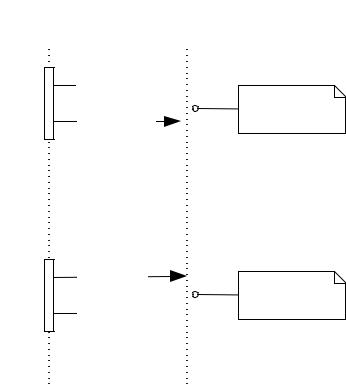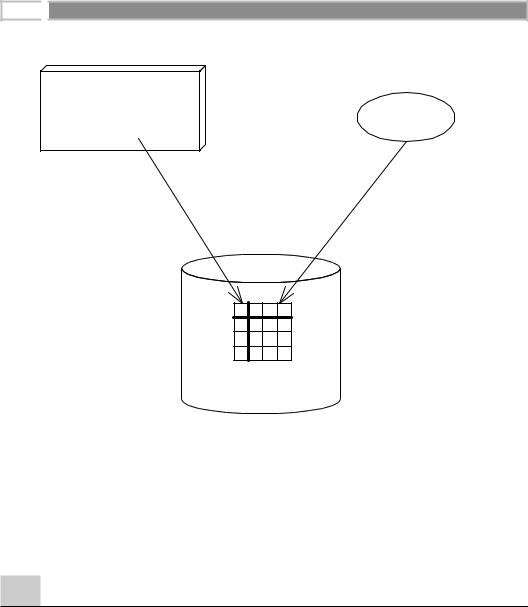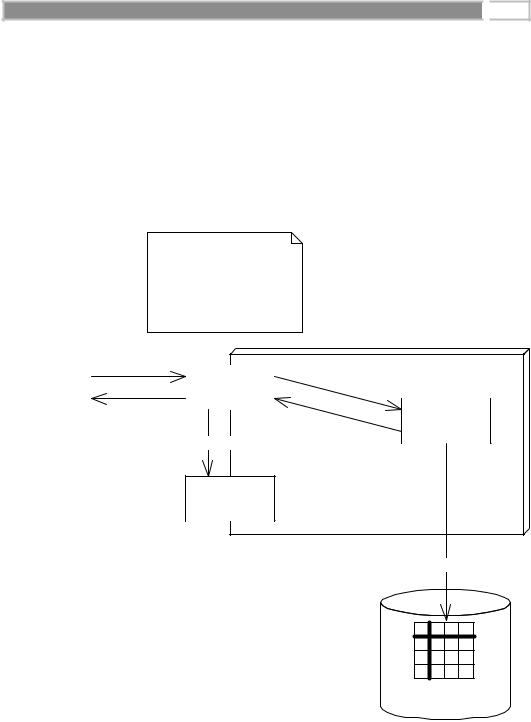
Mastering Enterprise JavaBeans™ and the Java 2 Platform, Enterprise Edition - Roman E
..pdf
188 |
|
M A S T E R I N G |
E N T E R P R I S E J A V A B E A N S |
||||
|
|
|
|
|
|
|
|
|
|
|
Container |
|
|
Bean Instance |
|
|
|
|
|
|
|
|
|
1: ejbStore() 
Passivation entails a
state save.
2: ejbPassivate()
1: ejbActivate()
Activation entails a state load.
2: ejbLoad() 
Figure 7.3 Passivation of entity beans entails a state save, and activation entails a state load.
There Are Two Ways to Persist Entity Beans
As should be clear by now, entity beans are persistent objects that know how to render themselves into a data store, such as a relational database via O/R mapping or an object database. One way to do this is to implement a set of database calls within your bean. For example, with a relational database, your entity bean could perform an SQL INSERT statement via JDBC to stick some data into a relational database. You could also perform an SQL DELETE statement via JDBC to remove data from the underlying store. This mechanism of persistence is called bean-managed persistence because the bean itself is managing all of its storage.
EJB offers an alternative to bean-managed persistence: You can have your EJB container perform your persistence for you. In this case, you’d usually strip your bean of any persistence logic. Rather than hard-coding persistence into your bean class, you simply tell your EJB container which public fields of your bean are persistent fields. You tell the container this via your entity bean’s deployment descriptor. Once you’ve informed the container about what fields to persist, the
Go back to the first page for a quick link to buy this book online!

Introduction to Entity Beans 
 189
189
EJB Design Strategies
Partitioning Your Resources
When programming with EJB, I’ve found it very handy to separate the kinds of resources your beans use into two categories: bean-specific resources and bean-independent resources.
Bean-specific resources are resources that your bean uses that are tied to a specific data instance in an underlying storage. For example, a socket connection is a beanspecific resource if that socket is used only when particular bank account data is loaded. That is, the socket is used only when your bean instance is bound to a particular EJB object. Such a resource should be acquired when a bean instance is activated and released when the instance is passivated.
Bean-independent resources are resources that can be used over and over again, no matter what underlying data your instance represents. For example, a socket connection is a bean-independent resource if my bean can reuse that socket no matter what bank account my bean represents (that is, no matter what EJB object your bean instance is assigned to). Global resources such as these should be acquired when your bean is first created, and they can be used across the board as your bean is assigned to different EJB objects. The callback that the container invokes when first creating your bean instance is called setEntityContext(), and you should acquire your beanindependent resources here. Similarly, the unsetEntityContext() method is called directly before your bean instance is destroyed, and thus you should release beanindependent resources there. Combined, these two methods demarcate the lifetime of a particular entity bean instance—we’ll see how to use them in the pages to come.
Because acquiring and releasing resources may be costly operations, categorizing your resources as outlined is a vital step that you must take. Of course, the most stingy way to handle resources is to acquire them on a just-in-time basis and release them directly after use. For example, you could acquire a database connection only when you’re about to use it and release it when you’re done. Then there would be no resources to acquire/release during activation/passivation. In this case, you’d let the container pool your resources and thus manage the resources for you. The disadvantage to this is you need to code resource requests/releases over and over again in your bean code.
container will automatically handle your data access logic for you. For example, if you’re using a relational database, the container may automatically perform SQL INSERT statements to create database data. Similarly, it will automatically perform SQL DELETE statements to remove database data, and it will handle any other necessary persistent operations. Even if you are not working with a relational database, you can have your container persist for you. If your container supports a nonrelational persistent store, such as an object database or
Go back to the first page for a quick link to buy this book online!

190 
 M A S T E R I N G E N T E R P R I S E J A V A B E A N S
M A S T E R I N G E N T E R P R I S E J A V A B E A N S
a VSAM file, the container will generate the appropriate logic as necessary. This automatic persistence of entity beans is called container-managed persistence. It is up to the EJB deployer to specify exactly how your entity bean should map to an underlying data storage, such as a customer ID Java object field mapping to a customer ID column in a relational database table. This is a huge benefit of entity beans, because you can write storage-independent data objects and reuse them in a variety of enterprise environments.
Container-managed persistence reduces the size of your beans tremendously because you don’t need to write JDBC code—the container handles all the persistence for you. Needless to say, this is a huge value-add feature of EJB. Of course, it still has a long way to go, as most things do in the EJB world. Once we’ve written a few entity beans, we’ll review the trade-offs of bean-managed versus container-managed persistence (see Chapter 9).
Entity Beans Can Be Created, Removed, or Found
When you learned about session beans, you saw that session beans support methods for initialization as well as destruction. To initialize a session bean, the container calls session bean’s ejbCreate() method, allowing the bean to prepare itself for use. Similarly, when a session bean is about to be destroyed, the container calls the bean’s ejbRemove() method, allowing the bean to prepare itself for destruction.
With entity beans, initialization and destruction work a bit differently. Entity beans are a view into a database, and you should think of an entity bean instance and the underlying database as one and the same (they are routinely synchronized). Because they are one and the same, the initialization of an entity bean instance should entail initialization of database data. Thus, when an entity bean is initialized in memory during ejbCreate(), it naturally makes sense to create some data in an underlying database that correlates with the in-memory instance. That is exactly what happens with entity beans. When a bean-managed persistent entity bean’s ejbCreate() method is called, the ejbCreate() method is responsible for creating database data. Similarly, when a bean-managed persistent entity bean’s ejbRemove() method is called, the ejbRemove() method is responsible for removing database data. If container-managed persistence is used, the container will modify the database for you, and you can leave these methods empty of data access logic.
Because entity bean data is uniquely identified in an underlying storage, entity beans can also be found rather than created. Finding an entity bean is analogous to performing a SELECT statement in SQL. With a SELECT statement, you’re searching for data from a relational database store. When you find an entity bean, you’re searching a persistent store for some entity bean data. This
Go back to the first page for a quick link to buy this book online!

Introduction to Entity Beans 
 191
191
differs from session beans because session beans cannot be found—they are not permanent objects, and they live and die with the client’s session.
You can define many ways to find an entity bean. You list these ways as methods in your entity bean home interface. These are called finder methods. Your home interface exposes finder methods in addition to methods for creating and destroying entity beans. This is the one big difference between an entity bean’s home interface and a session bean’s home interface—session bean home interfaces do not have finder methods.
Entity Beans Can Represent Legacy Data and Legacy Systems
There can even be entity beans that in effect were around before EJB. This means you can take an existing legacy database or existing legacy system and represent it as a suite of entity beans. For example, IBM is working on an EJB facade to CICS systems. Some EJB product vendors should provide tools to map entity beans to MVS systems using IMS or VSAM, as well as to packaged application systems such as SAP R/3 and PeopleSoft.
Mapping to legacy systems is no simple task. Typically, a specialized EJB container vendor will provide the tools necessary to map EJB to legacy systems. There are also emerging tools to assist the user in mapping complicated database structures or complex legacy object-relational mapping schemas.
You may be wondering why entity beans can be used to represent both database data as well as existing legacy systems. Why are entity beans the right abstraction to be using for legacy integration? Indeed, they may not be, as there are many problems with hooking into an existing system such as an SAP R/3 or CICS system. Sun is aware of this and has tentative plans to provide a separate abstraction for legacy integration. In the future, there will be special connectors that know how to access existing systems, as well as access beans to access those connectors. This should in turn spawn a separate market of EJB connector providers.
Unfortunately, at the time of this writing, connectors and access beans are still a whiteboard idea, so it may be awhile before deployments really get to make use of these constructs
Entity Beans Can Be Modified without Going through EJB
Usually, you will create, destroy, and find entity bean data by using the entity bean’s home object. But you can interact with entity beans another way, too: by directly modifying the underlying database where the bean data is stored. For example, if your entity bean instances are being mapped to a relational database, you can simply delete the rows of the database corresponding to an entity
Go back to the first page for a quick link to buy this book online!

192 
 M A S T E R I N G E N T E R P R I S E J A V A B E A N S
M A S T E R I N G E N T E R P R I S E J A V A B E A N S
EJB Container/Server
|
|
|
|
|
Entity Beans |
|
Existing App |
|
|
|
|
O/R Mapping |
|
Direct Database Modifications |
entity bean data
Relational Database
Figure 7.4 Modifying an entity bean’s database representation manually.
bean instance (see Figure 7.4). You can also create new entity bean data and modify existing data by directly touching the database. This may be necessary if you have an investment in an existing system that touches a database directly.
Developing and Using Entity Beans
Now that you’ve got a background in entity bean theory, let’s see what’s involved in writing and using entity beans. To write an entity bean class, your class must implement the javax.ejb.EntityBean interface. This interface defines a number of required methods that your entity bean class must implement. Most of these methods are management methods that are called by your EJB container. The following code details javax.ejb.EntityBean, as well as its parent, javax.ejb.EnterpriseBean:
The javax.ejb.EnterpriseBean interface (Source 7.1) defines no methods (it is simply a marker interface). The javax.ejb.EntityBean interface (Source 7.2)
Go back to the first page for a quick link to buy this book online!

Introduction to Entity Beans 
 193
193
public interface javax.ejb.EnterpriseBean implements java.io.Serializable {
}
Source 7.1 The javax.ejb.EnterpriseBean interface.
public interface javax.ejb.EntityBean implements javax.ejb.EnterpriseBean { public abstract void setEntityContext(javax.ejb.EntityContext);
public abstract void unsetEntityContext(); public abstract void ejbRemove();
public abstract void ejbActivate(); public abstract void ejbPassivate(); public abstract void ejbLoad(); public abstract void ejbStore();
}
Source 7.2 The javax.ejb.EntityBean interface.
defines callback methods that your bean must implement. The container will call these methods whenever it wishes.
In addition to the methods shown, you would typically define a few ejbCreate() methods to create new entity bean data and a few ejbFind() methods to find existing bean data.
Creation of Entity Beans: ejbCreate()
An entity bean instance’s ejbCreate() method is used to initialize a bean for a particular client and to create underlying database data. Each ejbCreate() method you define gives clients a different way to create your entity beans.
Here are some of the rules about ejbCreate():
You do not need to write any ejbCreate() methods with entity beans.
Session beans require ejbCreate() methods, but they’re optional for entities. You’d define an ejbCreate() method if you want to provide a way to create some underlying data through EJB. But remember that EJB does allow for you to create data indirectly, via direct database inserts or legacy systems. Thus ejbCreate() is optional.
The parameters to ejbCreate() can vary. This allows for multiple ways to initialize an entity bean instance and thus allows for different ways to create entity bean data in a database. For example, one ejbCreate() method might create a checking account, while another might create a savings account.
Go back to the first page for a quick link to buy this book online!

194 
 M A S T E R I N G E N T E R P R I S E J A V A B E A N S
M A S T E R I N G E N T E R P R I S E J A V A B E A N S
You must duplicate your ejbCreate() methods in your home interface.
In EJB, remember that clients don’t directly invoke on beans—they invoke an EJB object proxy. The EJB object is generated through the home object. Therefore, for each ejbCreate() method signature you define in your bean, you must define a corresponding create() in the home interface. The client calls the home object’s create(), which delegates to your bean’s ejbCreate().
For example, let’s say you have a bean-managed persistent bank account entity bean class called AccountBean, with a remote interface Account, home interface AccountHome, and primary key class AccountPK. Given the following ejbCreate() method in AccountBean:
public AccountPK ejbCreate(String accountID, String owner) ...
you must have this create() in your home interface (notice there is no “ejb” prefix):
public Account create(String accountID, String owner) throws ...
Notice that there are two different return values here. The bean instance returns a primary key (AccountPK), while the home object returns an EJB object (Account). This makes sense—the bean returns a primary key to the container (that is, to the home object) so that the container can identify the bean. Once the home object has this primary key, it can generate an EJB object and return that to the client. We show this process more rigorously with the sequence diagram in Figure 7.5.
Finding Existing Entity Beans: ejbFind()
Your entity bean class’s finder methods are used to find an existing entity bean in storage. Finder methods do not create any new database data—they simply load some old entity bean data. You can have many different finder methods, which all perform different operations:
/**
* Finds the unique bank account indexed by primary key key */
public AccountPK ejbFindByPrimaryKey(AccountPK key)
/**
*Finds all the product entity beans. Returns an Enumeration
*of primary keys.
*/
public Enumeration ejbFindAllProducts()
Go back to the first page for a quick link to buy this book online!

Introduction to Entity Beans 
 195
195
/**
*Finds all Bank Accounts that have at least a minimum balance.
*Returns an Enumeration of primary keys.
*/
public Enumeration ejbFindBigAccounts(int minimum)
/**
* Finds the most recently placed order */
public OrderPK ejbFindMostRecentOrder()
Relationship between create() and ejbCreate().
[Diagram leaves out a few minor steps, and happens to assume bean-managed persistence]
|
|
|
|
|
|
|
|
|
|
|
|
EJB Container/Server |
|
|
|
|
|
|
|
|
|
|
|
|
|
|
|
|
|
|
|
|
|
|
|
|
|
|
|
|
|
|
|
|
|
|
|
|
|
|
|
|
|
|
|
|
|
|
|
|
|
|
|
|
|
|
|
|
|
|
|
|
|
|
|
|
|
|
|
|
|
|
|
|
|
|
|
|
|
|
|
|
|
|
|
|
|
|
|
|
|
|
|
|
|
|
|
|
|
Entity Bean |
|
|
|
|
|
|
|
|
|
|
|
|
|
||
|
|
|
|
|
|
|
|
|
|
|
|
||
|
|
|
1: create() |
|
4: return primary key |
Instance |
|||||||
Client Code |
|
|
|
|
|
Home Object |
|
|
2: ejbCreate() |
|
|
||
|
|
6: return EJB object |
|
|
|
|
|
|
|
||||
|
|
|
|
|
|
|
|
|
|
|
|
|
|
5: Create EJB object
EJB Object
3: Create database data
entity bean data
Database
Figure 7.5 Creating a bean-managed persistent entity bean and EJB object.
Go back to the first page for a quick link to buy this book online!

196 
 M A S T E R I N G E N T E R P R I S E J A V A B E A N S
M A S T E R I N G E N T E R P R I S E J A V A B E A N S
Here are some of the rules about finder methods:
All finder methods must begin with “ejbFind.” This is simply a syntactic rule.
You must have at least one finder method, called ejbFindByPrimaryKey.
This method finds one unique entity bean instance in the database based on its unique primary key. Because every entity bean has an associated primary key, it makes sense that every entity bean class supports this method.
You can have many different finder methods, with different names and different parameters to each method. This allows you to find using different semantics, as illustrated by the previous examples.
A finder method must return either the primary key for the entity bean it finds or an enumeration of primary keys if it finds more than one.
Because you could find more than one data instance in the database, finder methods can return enumerations of primary keys. Note that EJB 1.1 allows finder methods to return collections rather than enumerations. Collections are much more powerful to work with than enumerations.
As with ejbCreate(), clients do not invoke your finder methods on the bean instance itself. A finder method is just like any other method on your entity bean class—clients never directly call any of your bean’s methods. Rather, clients invoke finder methods on home objects, implemented by the EJB container, that delegate to your bean. Therefore, for each finder method you define in your bean class, you must define a corresponding finder in the home interface. Clients call your home object’s finder methods, which delegate to your bean’s finders.
For example, given the following finder method in AccountBean:
public Enumeration ejbFindAllProducts() ...
you must have this finder in your home interface (notice there is no “ejb” prefix):
public Enumeration findAllProducts() ...
A special rule about finder methods is that you implement finders only for beanmanaged persistent entities. If you’re using container-managed persistence, your EJB container will implement the finder methods in the EJB object (or somewhere else) for you. After all, the container is responsible for all data access logic. You’ll see more about this when we discuss container-managed persistence in Chapter 9.
Go back to the first page for a quick link to buy this book online!

Introduction to Entity Beans 
 197
197
As with ejbCreate(), you must define your finder methods in your home interface and implement your finder methods in your entity bean class. For example, if you have the following finder implementation signature in your entity bean class:
public AccountPK ejbFindBigAccounts(int minimum) throws ...
you must have this finder signature in your home interface (notice there is no “ejb” prefix):
public Account findBigAccounts(int minimum) throws ...
Notice that (as with ejbCreate()) our method signatures have two different return values: the entity bean instance returns a primary key to the container, whereas the home object returns an EJB object to the client.
Destruction of Entity Beans: ejbRemove()
To destroy an entity bean’s data in a database, the client must call remove() on the EJB object or home object. This method causes the container to issue an ejbRemove() call on the bean. We show this in Figure 7.6.
Note that ejbRemove() does not mean the in-memory entity bean instance is going to be destroyed—ejbRemove()destroys only database data. The bean instance can be recycled to handle a different database data instance, such as a bank account bean representing different bank accounts.
ejbRemove() is a required method of all entity beans, as it is of session beans, and it takes no parameters. There is only one form of ejbRemove(). With entity beans, ejbRemove() is not called if the client times out because the lifetime of an entity bean is longer than the client’s session.
Entity Contexts
As you learned in Chapter 6, all enterprise beans have a context object that identifies the environment of the bean. These context objects contain environment information that the EJB container sets. Your beans can access the context to retrieve all sorts of information, such as transaction and security information.
Go back to the first page for a quick link to buy this book online!
